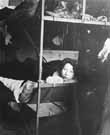
|
|
|

|

|

|

|
|
Click on an image to see a larger, more detailed picture.
|
|
|
|
|
| 1938: The End of Illusions |

|
pg. 141 |

|
|
|
|
| |
 Nettie Stub Katz peers out from her wooden bunk at the Zbaszyn, Poland, refugee camp near the German border. About 17,000 Polish Jews were stranded in the frontier town of Zbaszyn after the Nazis expelled Jews of Polish nationality from Germany and the Poles refused to admit them back into their country. Katz spent almost a year in the camp before obtaining an entrance visa to Sweden, where she survived the war.
Nettie Stub Katz peers out from her wooden bunk at the Zbaszyn, Poland, refugee camp near the German border. About 17,000 Polish Jews were stranded in the frontier town of Zbaszyn after the Nazis expelled Jews of Polish nationality from Germany and the Poles refused to admit them back into their country. Katz spent almost a year in the camp before obtaining an entrance visa to Sweden, where she survived the war.
Photo: Nettie Stub Katz/United States Holocaust Memorial Museum Photo Archive
|
 Neuengamme
Neuengamme
In December 1938 the SS bought a closed-down brick factory at Neuengamme, a town near Hamburg, Germany, on the marshy bank of the Elbe River. Inmate labor from the nearby Sachsenhausen concentration camp was brought in to renovate the factory. Within two years, the SS converted the site into a concentration camp that provided cheap labor for the armaments industry. More than 100,000 prisoners were sent to Neuengamme and satellite camps, including 14,000 women and hundreds of children. The camp imprisoned Poles, Russian POWs, and others of diverse nationalities. Most Jews were shipped to Auschwitz. Exhausted, underfed inmates slaved at back-breaking work. They cut, loaded, and transported wet, heavy clay from the morass surrounding the camp. They dug mud from a nearby canal. They lifted hot, glowing bricks without protective equipment. Skilled inmates manufactured pistol and grenade parts, or repaired U-boat engines. Women made gas masks and concrete products. Production quotas were extremely high, penalties severe. Failure meant death. Saboteurs were hanged. Overwork, disease, and medical "experiments" caused more than half of Neuengamme's inmates to perish.
Photo: KZ Gedenkstätte Neuengamme/United States Holocaust Memorial Museum Photo Archive
|
|

|

|

|

|
 November 9-10, 1938: Hitler mentions to Hermann Göring that he would like to see all German Jews forcibly resettled on the island of Madagascar. Opportunistically chosen by the Nazi leadership, the date of the pogrom is of great symbolic importance. It coincides with two important national holidays, the Nazi Blood Witness Day of November 9 and Martin Luther's birthday of November 10. Blood Witness Day commemorates the Nazi "martyrs" who died for their cause. Martin Luther advocated the destruction of Jewish homes and synagogues as well as the impoverishment, forced labor, exile, and death of Jews.
November 9-10, 1938: Hitler mentions to Hermann Göring that he would like to see all German Jews forcibly resettled on the island of Madagascar. Opportunistically chosen by the Nazi leadership, the date of the pogrom is of great symbolic importance. It coincides with two important national holidays, the Nazi Blood Witness Day of November 9 and Martin Luther's birthday of November 10. Blood Witness Day commemorates the Nazi "martyrs" who died for their cause. Martin Luther advocated the destruction of Jewish homes and synagogues as well as the impoverishment, forced labor, exile, and death of Jews.
|
|
|
|
|
| 1938: The End of Illusions |

|
pg. 141 |

|
|
The Holocaust Chronicle
© 2009 Publications International, Ltd.
|
|
